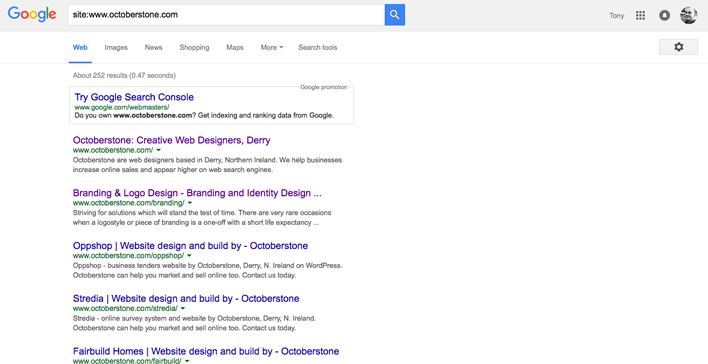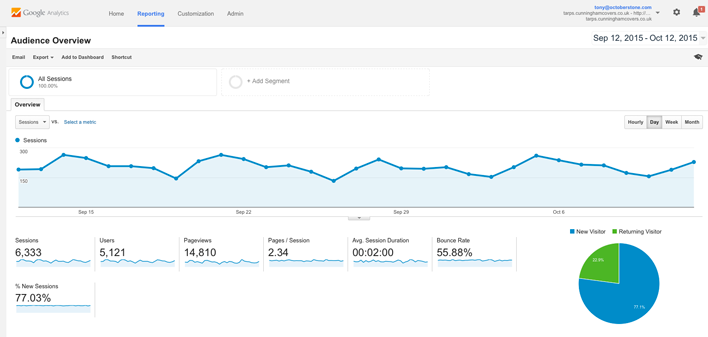Changing your website name? Learn how to avoid the pitfalls
Changing the domain name of your website is not a decision that should be taken on a whim. If you do decide to do it there are some simple but vital steps that you need to follow – if not, the effect on your online strategy can be extremely damaging. A few days ago a phone call enquiry from a local organisation led us to uncovering one such example!
The manager contacted us requesting a quotation for an app to complement their new website. They explained that the business was a charity established more than 10 years ago, and provides very useful services to local, medium and large sized business in Northern Ireland. They are partly public funded and have proven to its funders over the years that the services it provides are useful and are being used. Due to the demand for these services, it has expanded into other geographical areas in Northern Ireland. On the back of this expansion it was decided a name change was required.
They have now renamed the organisation, purchased a new domain name and created a new website.
The manager emailed the link to the new website. When I clicked this link I was greeted with a ‘this domain has expired’ notice! I immediately realised that they must have mistakenly sent me a link to their old website.
This confusion raised a few questions in our minds, and required a little investigation. We ran a whois search on this domain name. The whois results showed that it had expired in the past 20 days. On contacting the business again a different link was provided which worked and displayed a functioning website.
A whois search on this working domain name showed that it had been registered in the past 10 days.
We ran a Google site search (type site:www.yourdomainname.com into Google) on the first domain. It showed that a considerable number of pages had been indexed (recorded on the Google search engine) and displayed in its search results but of course these links no longer worked as the domain had expired.
We ran the same Google search on the live domain. It showed that only 2 pages had been indexed. An examination of the site indicated that it had 10 pages and so in theory 10 pages would be expected to have been indexed.

As the organisation has changed its domain name, they assumed that they no longer required the original domain and duly let it expire. They registered the new domain name, built a new website using a free website builder and expected that the site would be picked up by search engines and their audience would just find them. They didn’t realise that this would not happen and they now had a major problem.
The problem
The old site was gone and the new site could not be found. How are their clients going to find them?
They had taken the cheap option of using a free website builder that was not search engine friendly, which explained why so few of their site web pages were appearing on any search engine.
It was wrong for them to assume that they no longer required the original domain name. They didn’t stop to think how they were going to inform all that knew them or used their services in the past that they had changed their name and website. They were not knowledgeable of the fact that since the original domain was registered in 2005, it had earned much valued history – age history, content history, search engine ranking and much valued backlinks (links to other websites). Now they are starting back to where they were in 2005 – all that effort, over all those years, lost.
It is possible to get a new domain to the same position in a period of months if a good search engine strategy is put in place, but in this instance we are talking about a charity with public funding that has a responsibility to be prudent with its finances.
What they should have done
They were not aware how important this history and search engine ranking was to them, to their customers and to their budget. They did not realise that this history and ranking could very easily be transferred to the new domain.
Audit the old web site
They should have got in touch with a reputable web company that would have carried out an audit of the old website and recorded the following information:
- the number of daily, weekly and monthly visits;
- the top pages visitors landed on first (top landing pages);
- any websites linking to the site;
- all internal links (site pages linking to other pages within the site);
- the top keywords; and
- all pages and images recorded (indexed) on the Google search engine.
This information is vital, as it gives a true picture of the status and performance of the website. It also creates a benchmark to compare the old site with the new site.
Two of the tools to find this information is Google Analytics and Google Webmaster Tools which the web company would set up and install with the correct tracking code on the old site.
Set up and redirect traffic to the new website
After buying the new domain and creating the new website the following would be carried out:
- inform Google that the website name has changed using their change of address tool which “manages the transition needed by Google to index your new URLs at the new address, while minimizing impact to your current ranking in Google Search results.”;
- ensure the new site is built to be search engine friendly;
- move all content from the old site to the new site;
- redirect all traffic going to the old site pages to an equivalent page on the new site;
- check for any broken links or missing pages; and
- inform any organisations who have website links to the old site of the site name change.
The outcome
If these steps are followed correctly:
- all visitors to the old website will be automatically redirected to the new site;
- Google will eventually index all the pages on the new site, and in time the old site can be closed down along with the domain name; and
- it will save substantial costs informing all that know them or have used their services that there is a new domain name and organisation name change.
When site traffic is analysed, there should be no noticeable drop in website visitors when compared to the old site. It will be as if there was never a website change.
Conclusion
How your website is listed on any search engine and how visitors find your site is very important for all website owners to understand.
There is a place for free website builders but they do not suit all websites, especially those that have been established for some time and need to change to a new domain name.
Local web design companies will know the local market and more than likely, will have worked with businesses and organisations that you, yourself will know. Talk to them, find out who they have worked with, if they have a good reputation and can help. Avoid the free option.
By the way… we advised the charity not to create an app – we suggested they to use the money instead to get their website working correctly!
